The importance of data cannot be overestimated in this digital world.
Thankfully, data visualization tools like Tableau, Power BI, Grafana, Qlikview and others streamline the process of collecting, storing, and presenting data.
In fact, top companies utilize such tools for their business intelligence strategies. Moreover, there’s the option of raw or visual data, although visual information is more preferred because it is relatively easier to comprehend.
On the other hand, Tableau is one of the popular data visualization tools across the world. Though in this post, we will show you 15 best Tableau sales dashboard examples but if you want to learn more about Tableau, this article lists some of the best Tableau courses in the market. You must check it out.
Before we show you the best Tableau sales dashboard examples, let’s answer the basic question – what is Tableau, and how does it work?
- What Is Tableau And How Does It Work?
-
15 Best Tableau Sales Dashboard Examples
- 1. Sales Forecast Dashboard
- 2. Sales Pipeline Dashboard
- 3. Sales Activity by Rep – Scorecard
- 4. Account Management – 360 Degree Customer View
- 5. Sales Lead and Account Activity Tracker
- 6. Sales Quota Dashboard
- 7. Sales Growth Dashboard
- 8. Sales Commission Model
- 9. Sales Call-Down Dashboard
- 10. Top Accounts
- 11. Sales Territory Assignments
- 12. Sales Segmentation
- 13. Sales Summary
- 14. Large Deals
- 15. Account Tracking
- Rounding Up
What Is Tableau And How Does It Work?
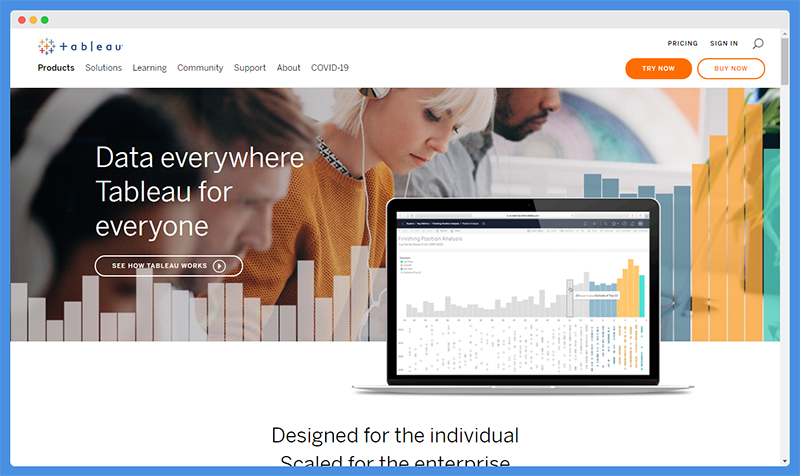
Tableau is a data visualization tool that focuses on three major areas – real-time analysis, data collaboration, and data blending. The software is powered using a unique technology known as VizQL.
Tableau is more like a software suite because there are multiple tools in the package. The suite includes:
- Tableau Desktop
- Tableau Prep
- Tableau Server
- Tableau Online
- Tableau Mobile
- Embedded Analytics
- Tableau Server Management
- Tableau Data Management
This implies that you can use the Tableau software on Desktop, online via a web browser, and on a mobile device via the app. Tableau analytics can as well be embedded on any webpage on your business website.
With Tableau, you can draw business data from different sources into one dashboard. That’s basically how the software works – integrating data from multiple sources.
You can create a customized sales dashboard with Taboola to monitor data. But, there are already pre-designed dashboard samples so that you can avoid the stress.
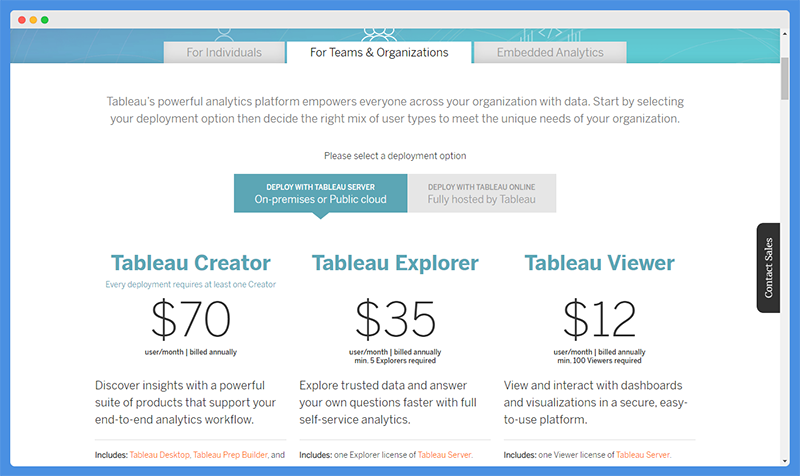
To use Tableau, you have to purchase a license. There are three options:
- Tableau For Individuals – $70 per month
- Tableau For Teams & Organizations
- Creator Plan – $70 per month
- Explorer Plan – $35 per month
- Viewer Plan – $12 per month
- Embedded Analytics – Custom pricing
Now that you know about Tableau, check out the best 15 Tableau sales dashboard examples below:
15 Best Tableau Sales Dashboard Examples
1. Sales Forecast Dashboard
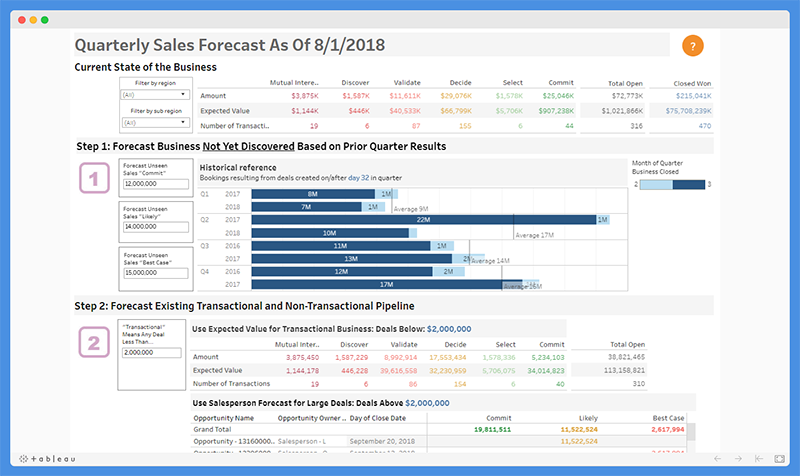
This Sales Forecast Dashboard is an ideal one for Tableau users that make frequent business decisions. The insights will give you a head-start on future predictions. It is a one-sheet workbook dashboard, and it is divided into four steps.
But first, there’s the current state of business rundown at the top that provides insights on spending, expected returns, and the number of transactions. You can sort the metrics based on region or subregion for deeper insights.
The first step on the dashboard covers business forecasts that are yet to be identified and they are based on the previous quarter results.
Transactional business insights below and above a specified amount (which you will set) are delivered on the second step. In contrast, the third step gives you insights into business opportunities that are likely to grow or accelerate.
Finally, the last step compares the forecast to quota; you still get to enter the value of the current business quarter quota.
Worth Reading: Best Tableau Retail Dashboard Examples
2. Sales Pipeline Dashboard
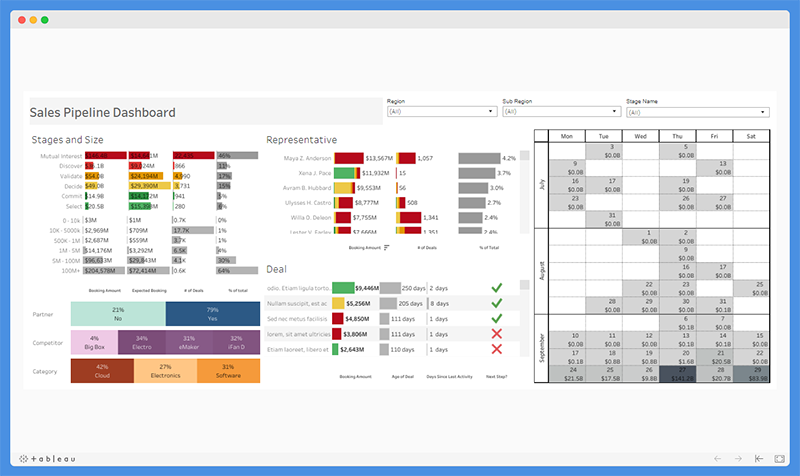
This dashboard uses pipeline dash metadata to deliver sales analytics. If you need a Tableau sales dashboard for sales pipeline management, this is an ideal one to consider.
It is a relatively simple dashboard divided into three sections – Stages & Sizes, Representative, and Deal.
There is also a sales value calendar at the right-hand side and the data can be sorted based on region, sub-region, or stage name.
From the Stages & Sales section, the quota of several sales prospects is featured. Insights on deals of business partners, competitors, and specific categories are also featured.
The Representative section lists out salespeople and the deals quota they are expected to close. You get the booking amount, the number of deals, and the percentage total.
The Deal, which is the last section, focuses on business deals. This includes data of deals booking amount, age, days since last activity, and insights on what next step to take.
3. Sales Activity by Rep – Scorecard

Straight to the point sales data, that’s what this Tableau sales dashboard aims to achieve.
This is an ideal dashboard if you are more interested in your sales personnel’s activities such as emails, calls, messages, and meetings. Those are the actionable insights that this dashboard delivers.
Specifically, they are Emails, Calls, LinkedIn Messages, Customer Meetings, and you get the grand total.
One look at the dashboard and get all this analytics, while the bar charts make them easy to comprehend. By hovering over any of the sellers, you can get their individual timeline metrics. This will enable you to identify hard-working sales personnel and those lazing around.
You can monitor staff activities under different managers. From the right-hand side of the dashboard, you can sort through the various sales managers and also filter the chart based on different time frames.
4. Account Management – 360 Degree Customer View
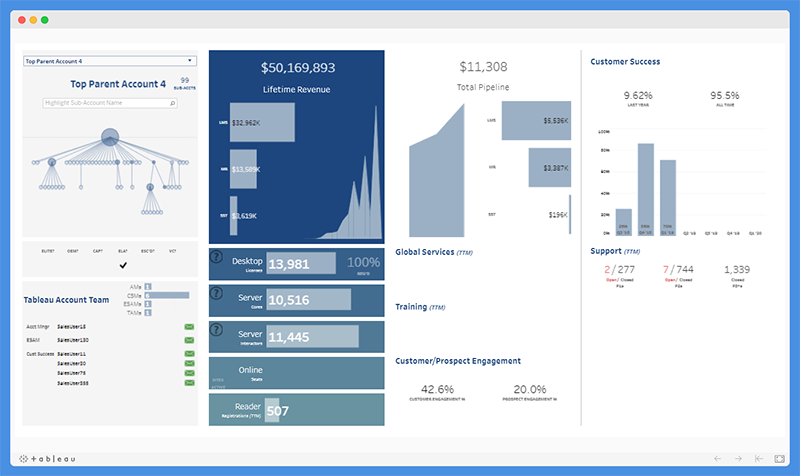
Want to monitor sales data of the customer’s account, a Tableau dashboard like the Account Management – 360 Degree Customer View will do justice. There are many sales indicators on this dashboard including lifetime revenue and total pipeline.
Your product or services are displayed along with how much customers have paid for them overtime; the total is the displayed lifetime revenue.
The same is for the total pipeline; the pipeline value of the products and services you offer are listed and the summation gives the total pipeline value.
At the top right corner is a section for monitoring parent accounts and their sub-accounts. You see the industry’s overflow and insights, annual revenue, employee count, territory, and closed-won opportunities amount.
The customer success section enables you to know how your customers are faring with success percentages.
5. Sales Lead and Account Activity Tracker
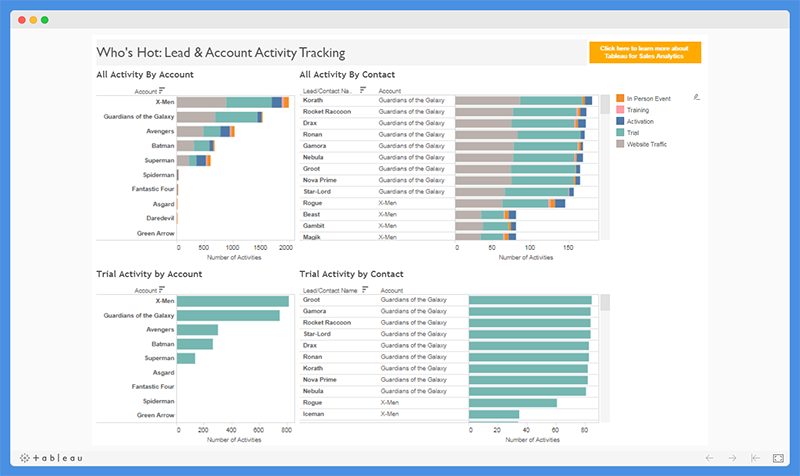
This is a Tableau sales dashboard example that is recommended for users that offer digital streaming services, whether video or audio content. It allows you to track the activities of users and the number of leads generated over time.
It is a one-sheet workbook dashboard divided into four categories; All Activity By Account, All Activity By Contact, Trial Activity By Account, and Trial Activity By Contact. In simple terms, the categories are for monitoring trial and actual users as well as content traffic.
Take the All Activity By Account as an example; it displays the number of traffic a particular content has gotten over time by trial and paid users. The Trial Activity By Account shows the amount of traffic a specific content has obtained from trial users alone.
For the All Activity By Contact and Trial Activity By Contact, instead of traffic to particular content, they track the traffic from a particular user.
6. Sales Quota Dashboard
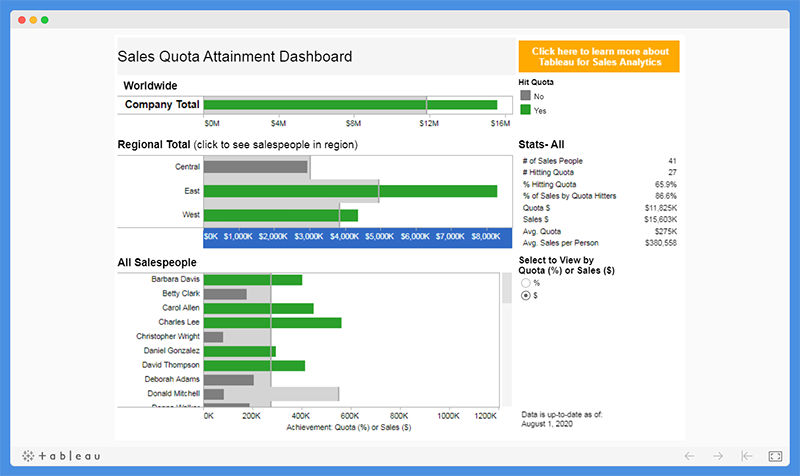
This Sales Quota dashboard is ideal for marketing businesses and companies. It consists of only three categories, and it is very easy to interpret.
The first category is the Company Total that delivers insight on company sales revenue and its difference from the company quota. You can easily know how many sales to make before you reach your set goal.
Regional Total, the second category, delivers insight on company sales revenue and its difference from the quota in specified regions. Note that the first category of insights is based on a global scale. With the regional Total, you can identify your top-selling product/services to channel your efforts appropriately.
The final category focuses on the sales insights of each salesperson. You can figure out how much revenue each staff is bringing in, and if you’ve set a specific quota for them, you can observe the difference.
7. Sales Growth Dashboard
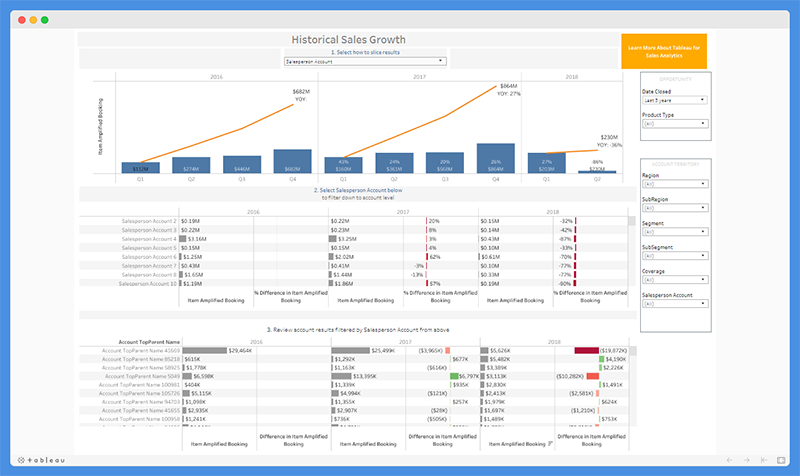
Here is another Tableau sales dashboard for large-scale business users. It enables you to see how your business has grown over time with a year comparison model.
The first section is the bar charts that display sales revenue from each quarter of the years. In this same section, the year-over-year (YOY) percentage is calculated and displayed using a line graph.
The next section reveals the sales revenue from workers while the last sections display sales by account name.
From the top of the dashboard, you can generally select how to display the stats. Options available include region, sub-region, segment, sub-segment, model, coverage, and salesperson account.
Also, from the right corner, you can sort the date, region, and more. You can compare results from each quarter of more than 10 years at a stretch.
8. Sales Commission Model
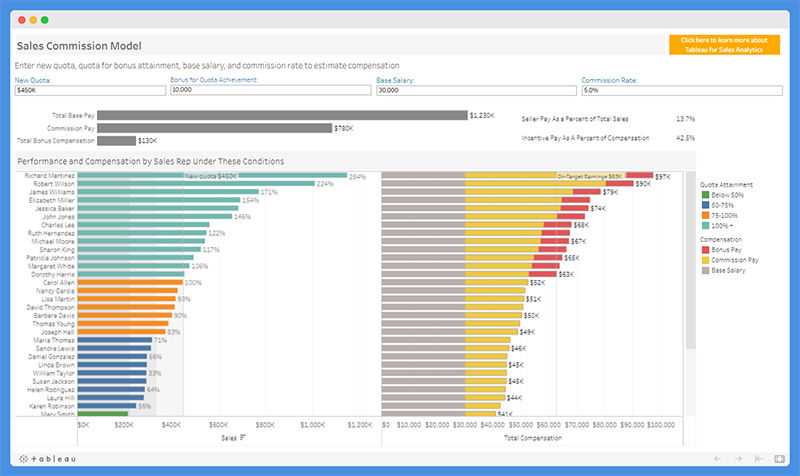
Do you run an affiliate or referral business model? If yes, then you should check out this Sales Commission Model Tableau dashboard. It uses bar charts to display the performance and revenue of various sales representatives.
You can set the quota value, bonus for quota achievement, base salary for the reps, and commission rate.
The bar charts displayed are two – the first gives insights on reps performance relating to the quota while the second gives insight on how much they’ve earned, including bonus, commission, and salary. By clicking on any sales reps, you can view their total sales and compensations.
The dashboard uses color codes to make it easier for you to understand the metrics. Different colors are used for bars of reps, depending on their quota achievement by percentage. Also, there are different colors for reps earnings.
9. Sales Call-Down Dashboard
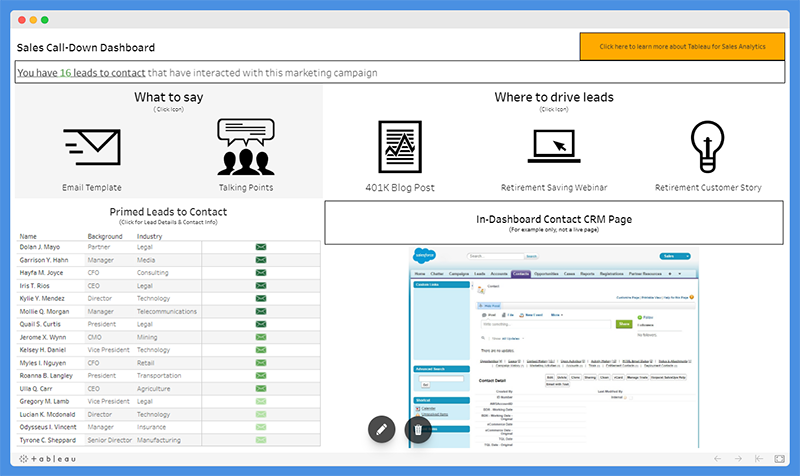
This Sales Call-Down Dashboard is ideal for tracking communication between companies, partners, and leads. It was designed to help the sales team to prioritize their workflow.
With a click, you can access email templates and talking points. Also, you can easily drive leads to webinars, stories, and blog posts with a click.
The dashboard displays the primed leads to contact according to their relevance. Insights presented include the lead name, background, and industry, but by clicking on each one, you can explore more details, including their contact information.
Also, a mail-contact icon is featured for each listed lead. When clicked, you have the option to send an email or call the selected lead.
You also can integrate a CRM third-party platform (Salesforce, for example) for active lead management via the in-dashboard section.
10. Top Accounts
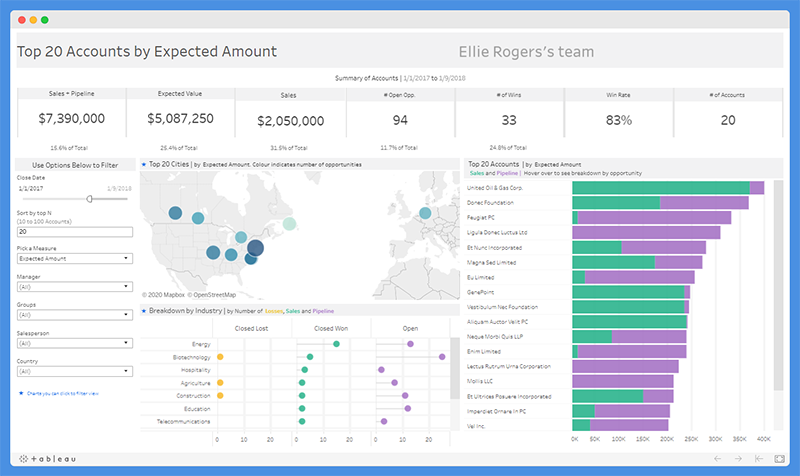
The description reveals the visual data this dashboard targets – data of top accounts. It displays a rundown of accounts revenue over a set time frame.
At the top, you can quickly view the sales + pipeline revenue, expected revenue, sales count, open opportunities, number of wins, wins rate, and number of accounts.
You can set any number of accounts to view their metrics between 10 and 100. A quick map shows you the hot regions, where the most sales were made; the darker the region indicator, the higher the sales and vice versa.
Below the map, you get a breakdown of the number of losses, sales, and pipeline by industry. Each features a unique color for easy identification.
The right-hand section shows top accounts by sales and pipeline. Again, these are color-differentiated and you can view the opportunities by hovering over the bar charts.
11. Sales Territory Assignments

This is a Tableau sales dashboard that displays sales data based on the territory, whether a local region, state, or country.
For each territory, you get insights on the number of accounts, open pipeline, current year spend, previous year spend, and lifetime spend.
There are filters on the right-hand tab for deeper insights. From here, you can sort through different segments, districts, states, territory owners, and territory names. Below the filters are options for sorting the featured parameters.
The Account Spend section displays insights on the individual spend value for salespeople, the total number of transactions, and the total value of the open pipeline.
Likewise, the Territory Map has different bubbles, which helps users to identify key sales activity areas. The map can be sorted based on the open pipeline, lifetime spend, etc.
12. Sales Segmentation

If your business is scaling big time across various regions, you’ll need a segmented sales dashboard to efficiently monitor each region. This Tableau Sales Segmentation Dashboard is one of the best sales dashboard examples for such a purpose.
The dashboard features sorting options on the left-hand side. You can sort regions by cardinal and ordinal directions such as west, east, southeast, northeast, etc. However, these can be customized.
For each region, three data sections include product mix by the percentage of sales, business mix by the percentage of sales, and sales by industry and states.
Data in the first two sections ranges across the four quarters of four years and are displayed in bar charts. The last section features different industries and the metrics are marked with bubbles.
13. Sales Summary

This is an ideal dashboard if you want a quick rundown of your business’s yearly sales. Like the previous dashboard, this one displays data for four quarters of 4 years, and you can sort these via the left-hand tab.
At the top of the dashboard, you can view the quarter-to-date (QTD) sales quota, current quarter quota, sales quota difference, QTD transactions, QTD customer count, and QTD opportunity quantity.
Below this are two sections; Accumulated Sales by Week of the Quarter and Sales Trend by Quarter. The first section displays QTD sales of each quarter week using line graphs, and they are readily compared with the current quarter quota.
The second section displays quarterly sales, transactions, customer count, and opportunity quantity of every quarter of the four years using bar charts.
14. Large Deals
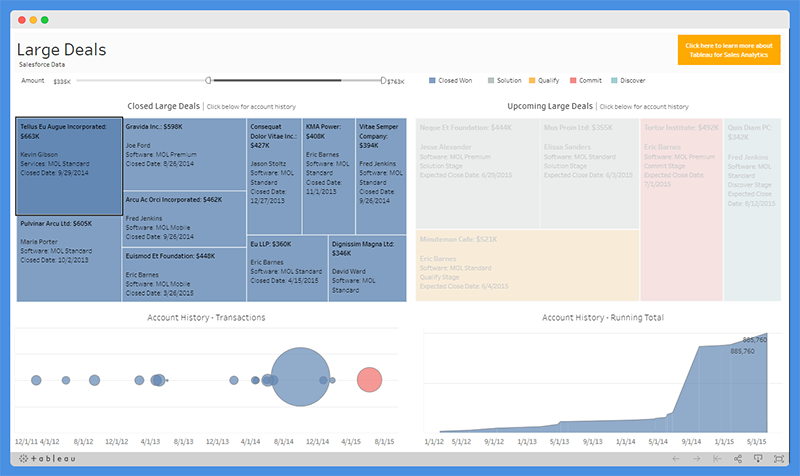
Don’t want to miss any of the large deals, here’s a Tableau dashboard you will appreciate. From the top, you can sort the featured deals based on their value; that’s how you can quickly identify the large deals.
The first two sections, Closed Large Deals and Upcoming Large Deals are merely for what their description states. From the Closed Large Deals section, you get a view of large deals you have closed, while from the Upcoming Large Deals, you get a view of future large sales.
Below these sections are two other sections; Account History – Transactions and Account History – Running Total.
The first provides metrics on previous transactions using bubbles; large bubbles represent large deals. The second provides metrics on revenue generated from these transactions.
15. Account Tracking

The last but not in any way least here is the Account Tracking dashboard, an ideal one for individual sales reps or marketers. It displays your set quota, sales value, active opportunities, losses, and wins.
There are options to filter the dashboard on the left-hand tab. The options include the date, salesperson, country, product/service, and industry. Next to it is the section for account size by amount.
The last section featured is the Opportunities section, where you can quickly view and compare wins and losses. Like most sales dashboards examples discussed, the metrics here are represented with bubbles.
Rounding Up
There you go! Fifteen of the best Tableau sales dashboard examples.
Investing money in quality data visualization tools is one way to take your business to the next level, and that is what you can achieve with Tableau.
With accurate and reliable data, businesses can make more informed decisions. If there’s any problem along the line, the visual insights will help you detect the cause so as to resolve it.
Tom loves to write on technology, e-commerce & internet marketing. I started my first e-commerce company in college, designing and selling t-shirts for my campus bar crawl using print-on-demand. Having successfully established multiple 6 & 7-figure e-commerce businesses (in women’s fashion and hiking gear), I think I can share a tip or 2 to help you succeed.